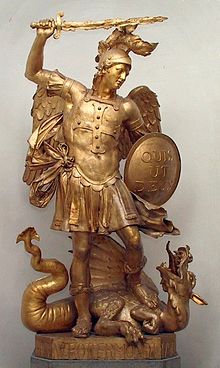- Michaelion
-
 Statue of Archangel Michael at the University of Bonn, representing his standard iconography, slaying Satan as a dragon or serpent, first depicted at Michaelion.[1] Quis ut Deus is inscribed on his shield.
Statue of Archangel Michael at the University of Bonn, representing his standard iconography, slaying Satan as a dragon or serpent, first depicted at Michaelion.[1] Quis ut Deus is inscribed on his shield.
The Michaelion was the earliest and most famous sanctuary to Archangel Michael in the ancient Near East.[2] It was built in the 4th century by Emperor Constantine, and was located just south of Constantinople.[2]
The location of the church, and the temple Sosthenion which had existed there had been previously associated with healing and medicine and the Christian tradition continued to associate the location and the Michaelion with healing waters.[1][3]
Michaelion was a magnificent church and its construction was followed by several other churches dedicated to Archangel Michael in Constantinople.[4] It then became a a model for hundreds of other churches in Eastern Christianity.[5]
Contents
Foundation
A temple called Sosthenion had existed at the location prior to the 4th century.[1][6] An ancient chronicle of Constantine states that he had entered the temple, and felt that the statue there represented a Christian angel. After sleeping the night in the temple, Constantine reported a vision that the angel was the Archangel Michael, and built Michaelion there to honor him.[7]
The location of the temple had been previously associated with healing and medicine and the Christian tradition continued to associate the location and the Michaelion with healing waters.[1]
Early 5th century Eastern Christian historian Sozomen recorded the devotions by the crowds at Michaelion and wrote of first-hand reports of healings at Michaelion, stating that he had himself received a healing.[3][4]
Battle and iconography
 A Constantine coin (c.337) showing his labarum spearing a serpent.
A Constantine coin (c.337) showing his labarum spearing a serpent.
Constantine was the first Roman Emperor to become a Christian and in 313 AD along with his co-Emperor Licinius signed the Edict of Milan, allowing Christians to worship freely and build public churches, rather than worshiping in secret.[8] [9] However, Constantine and Licinius later fought each other and in 324 AD Constantine defeated Licinius at the Battle of Adrianople, not far from the Michaelion - attributing the victory to Archangel Michael.[1]
Constantine felt that both Licinius and Arius were agents of Satan, and associated them with the serpent described in the Book of Revelation (12:9).[10] Constantine represented Licenius as a snake on his coins.[11] After the victory, Constantine commissioned a depiction of himself and his sons slaying Licinius represented as a serpent - a symbolism borrowed from the Christian teachings on the Archangel to whom he attributed the victory. A similar painting, this time with the Archangel Michael himself slaying a serpent then became a major art piece at the Michaelion and eventually lead to the standard iconography of Archangel Michael as a warrior saint.[1]
A model for other churches
After the construction of the church a monastery was added to it, and thereafter four other churches in honor of Archangel Michael followed it in Constantinople.[4] During the reign of the next several emperors after Constantine, the number of churches dedicated to Archangel Michael in Constantinople increased to fifteen.[4]
Michaelion was a magnificent church and based on the reports of miracles there it became a model for hundreds of other churches in Eastern Christianity.[5] However, Churches dedicated to the Archangel in Western Christianity lagged those in the East for some time.[5]
As at the Michaelion, the association of Archangel Michael with healing and protection continued into the 6th century, when after a plague in Rome, the sick slept at night in the church of Castel Sant'Angelo dedicated to him for saving Rome from the plague.[2][12]
See also
- St. Michael's Church
- St. Michael's Cathedral
References
- ^ a b c d e f Saint Michael the Archangel in medieval English legend by Richard Freeman Johnson 2005 ISBN 1843831287 pages 33-34
- ^ a b c Catholic encyclopedia: St. Michael the Archangel
- ^ a b The historians of late antiquity by David Rohrbacher 2007 ISBN 0415204593 page 153 [1]
- ^ a b c d The lives of the fathers, martyrs, and other principal saints by Alban Butler 2010 ISBN 1153754169 page 341 [[2]
- ^ a b c Sacred and Legendary Art by Anna Jameson 2004 ISBN 0766181448 page 92 [3]
- ^ Dublin University magazine: a literary and political journal, Volume 76, 1870, page 130
- ^ The making of Christian communities in late antiquity and the middle ages by Mark F. Williams 2004 ISBN 1898855773 page 36
- ^ The world of the early Christians by Joseph Francis Kelly 1997 ISBN 0814653138 page 158
- ^ Catholic encyclopedia Constantine the Great
- ^ Constantine and the Christian empire by Charles Matson Odahl 2004 ISBN 0415174856 page 315
- ^ A Companion to Roman Religion by Jörg Rüpke 2011 ISBN 1444339249 page 159
- ^ Alban Butler, The lives of the fathers, martyrs, and other principal saints Published by Published by J. Duffy, 1866 page 320
Categories:- 4th-century Christianity
- Christian organizations established in the 4th century
- Michael (archangel)
Wikimedia Foundation. 2010.
